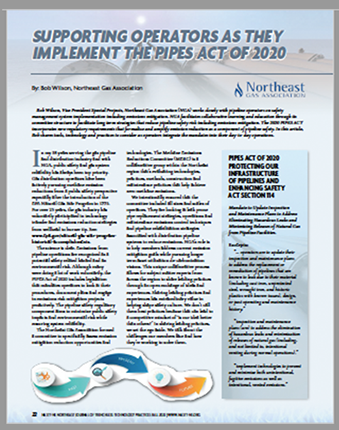By: Bob Wilson, Vice President Special Projects, Northeast Gas Association (NGA)
NASTT - Fall 2022
This summary contains excerpts from the article published in the Fall issue of NASTT.
Download the complete article PDF - Supporting Operators as they Implement the PIPES ACT of 2020 or click on the image below.
Bob Wilson of the Northeast Gas Association (NGA) works closely with pipeline operators on safety management system implementation including emissions mitigation. NGA facilitates collaborative learning and education through its committee structure to facilitate long term strategies that reduce pipeline safety risk including emissions mitigation. The 2020 PIPES ACT incorporates new regulatory requirements that formalize and amplify emission reduction as a component of pipeline safety. In this article, Bob shares tools, technology and practices to consider as operators integrate the mandates into their day-to-day operations.
In 38 years serving the gas pipeline and distribution industry and with NGA, public safety and gas system reliability has always been top priority. Gas distribution operators have been actively pursuing methane emission reductions from a public safety perspective especially after the introduction of the EPA Natural Gas Star Program in 1993. For over 25 years, the gas industry has voluntarily participated in technology transfer and emissions reduction strategies from wellhead to burner tip.
The science is clear. Emissions from pipeline operations are recognized as a potential safety related hazard and an environmental risk. Although many were doing a lot of work voluntarily, the PIPES Act of 2020 includes legislation that mandates operators to look at their procedures, document plans and engage in emissions risk mitigation projects proactively. The pipeline safety regulatory component aims to minimize public safety impacts and environmental risk while ensuring system reliability.
PIPES Act of 2020 Protecting our Infrastructure of Pipelines and Enhancing Safety Act Section 114
Mandate to Update Inspection and Maintenance Plans to Address Eliminating Hazardous Leaks and Minimizing Releases of Natural Gas from Pipeline Facilities. excerpts…
.. Operators are to update their inspection and maintenance plans to address the replacement or remediation of pipelines that are known to leak due to their material (including cast iron, unprotected steel, wrought iron, and historic plastics with known issues), design, or past operating and maintenance history."
- Inspection and maintenance plans (are) to address the elimination of hazardous leaks and minimization of releases of natural gas (including, and not limited to, intentional venting during normal operations)
-Implement technologies to prevent and minimize both unintentional, fugitive emissions as well as intentional, vented emissions.
CURED-IN-PLACE-LINING (CIPL) FOR LEAK PRONE PIPE
Mario Carbone, COO, Progressive Pipeline Management
CIPL is a proven and viable solution for gas operators to eliminate leaks and minimize emissions in compliance with the PIPES Act. Progressive Pipeline Management (PPM) has been working with gas companies utilizing Starline® Cured-In-Place-Lining (CIPL) for twenty years. The technology is being integrated into gas operators’ long-term strategy to manage leaking infrastructure. Many of the big leaks and gas main needs are in inner cities in the Northeast and metropolitan areas such as Chicago where cast iron pipes can be 60-100 years old.
The regulation identifies areas where Congress believes additional oversight, research, or regulations may be needed to protect the infrastructure of pipelines and enhance safety. Included within this act are new mandates for PHMSA require operators to update, as needed, their existing distribution integrity management plans, and O&M plans. PHMSA will also require that leak repair programs consider the environment and the use of advance leak detection practices and technologies.
CIPL allows gas operators to use advanced leak repair technology to permanently eliminate leaks and minimize methane emissions, while reducing the carbon footprint compared to traditional pipe replacement programs. PPM’s CIPL process and materials all fall within the strict confines of ASTM F2207 as well as ASTM D543. The cost savings and reduced carbon footprint compared to traditional “rip and replace” is significant. CIPL minimizes the impact of excavations, reduces traffic congestion and is proven to extend the life of renewed pipelines by 100 years. A lined pipe is considered a composite pipe, with leaks sealed and future leaks prevented.
Lining Myths
As effective as the technology is, there are still misperceptions that impede adoption. One myth is that the epoxy used in the liner is “glue.” PPM uses a two-part epoxy resin to structurally bond the liner to the host pipe, not at all glue. PPM’s epoxy cures, hardens, and fills up any gaps, cracks, or fissures. “Glue” has no such characteristics. Excessive “glue” impairs its ability to bond, and the objects won’t adhere properly. In contrast, PPM’s epoxy is moldable, and fills in surface irregularities and holes or deep cracks.
The excellent adhesive properties of PPM’s epoxy resin are due to the attractive forces between the epoxy resin and the surface of the substrate. These forces create a permanent bond that forms between the reactive sites in the resin and the surface of the substrate. The final product is a precise thermoset plastic, which is resistant to high operating temperatures, corrosion, UV exposure, and aggressive chemicals, oils and fluids. PPM’s epoxy’s structural permanent bond lasts as long as the bonded objects exist after the adhesive is fully cured and hardened.
Download the complete article PDF - Supporting Operators as they Implement the PIPES ACT of 2020.







